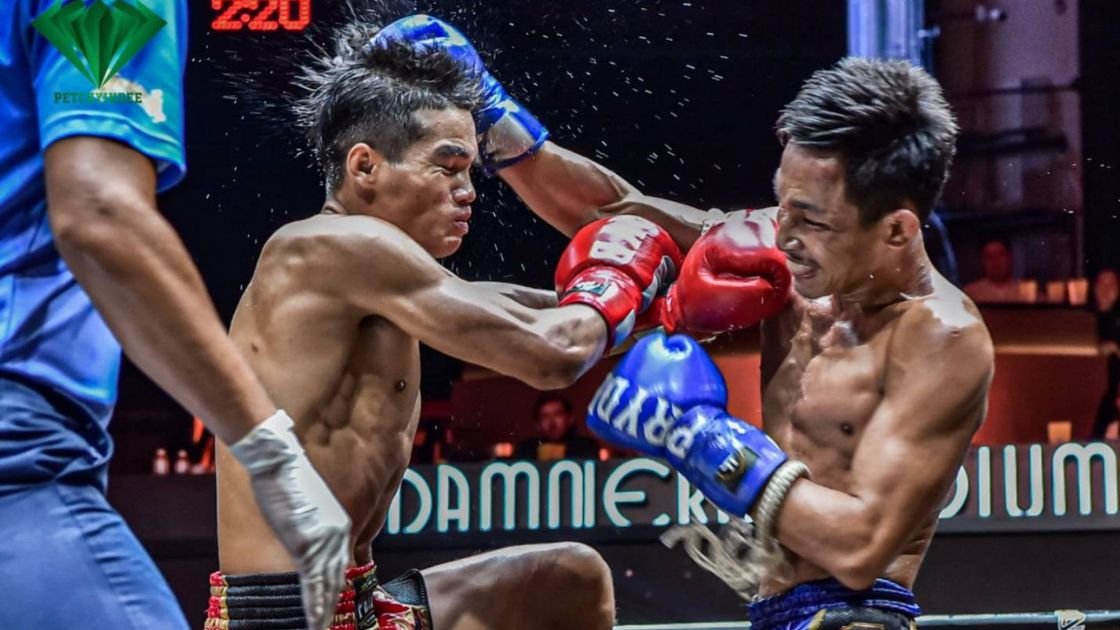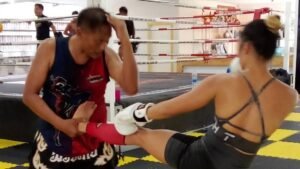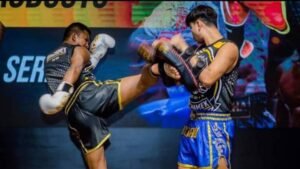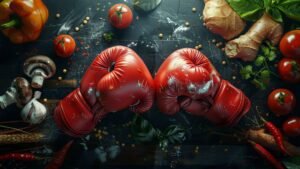Introduction to Muay Thai
Muay Thai, often referred to as “The Art of Eight Limbs,” is a traditional martial art and combat sport that originated in Thailand. Recognized for its distinctive use of fists, elbows, knees, and shins, Muay Thai distinguishes itself from other martial arts with its versatility and effectiveness. This ancient discipline is deeply embedded in Thai culture, reflecting the nation’s history, values, and customs.
The origins of Muay Thai date back several centuries, evolving from the traditional military training of ancient Siamese warriors. Over time, it transformed into a competitive sport, gaining popularity in Thailand and eventually worldwide. This martial art is not only a method of self-defense but also a means of physical conditioning, mental discipline, and cultural expression.
Muay Thai’s unique characteristics lie in its holistic approach to combat. It emphasizes close-quarters fighting with powerful strikes, clinching techniques, and strategic footwork. Practitioners, known as nak muay, undergo rigorous training to develop both physical prowess and tactical acumen. The sport’s focus on endurance, agility, and strength makes it a comprehensive form of exercise and a formidable combat system.
As we delve into the history and origins of Muay Thai, it is essential to appreciate its cultural significance in Thailand. Muay Thai is more than just a sport; it is a living testament to the resilience and spirit of the Thai people. Its customs, rituals, and traditions offer a window into the rich cultural heritage of Thailand. This exploration will uncover the historical evolution of Muay Thai, its role in Thai society, and its journey from ancient battlegrounds to modern-day arenas.
Origins of Muay Thai
Muay Thai, often referred to as the “Art of Eight Limbs,” has ancient origins deeply embedded within the early history of Thailand, previously known as Siam. The martial art traces its roots back to the early periods of Thai civilization, where it evolved from practical battlefield tactics into a refined form of close-combat martial arts. Its development can be linked to the necessity of defending the kingdom from various invasions and conflicts, leading to the refinement of techniques and strategies over centuries.
The emergence of Muay Thai as a distinct martial art is closely associated with the historical periods of the Sukhothai and Ayutthaya Kingdoms. During the Sukhothai era (1238-1438), the art form began to take shape as warriors trained in hand-to-hand combat to defend their lands. This period marked the early codification of techniques and the formalization of training methods that would lay the groundwork for what Muay Thai would become.
The Ayutthaya Kingdom (1351-1767) further cemented Muay Thai’s place in Thai culture. It was during this period that Muay Thai gained prominence, with the royal family and soldiers regularly practicing it. This era also saw the introduction of formal contests, where fighters would showcase their skills in public bouts. The sport began to gain a broader appeal, transcending its military origins and becoming an integral part of Thai society. The Ayutthaya period is often regarded as the golden age of Muay Thai, with the martial art reaching new heights in both technique and popularity.
Throughout these historical periods, Muay Thai continued to evolve, influenced by various cultural and societal changes. The martial art absorbed techniques from neighboring regions and adapted to the shifting dynamics of warfare and sport. The blend of historical necessity and cultural significance has ensured that Muay Thai remains a cherished tradition and a symbol of Thai identity.
Muay Thai in Ancient Warfare
Muay Thai, often referred to as the “Art of Eight Limbs,” has deep roots in the martial traditions of Thailand. Historically, it was not merely a sport but a vital component of ancient warfare, integral to the defense of the kingdom from numerous invasions. Thai soldiers were rigorously trained in Muay Thai, cultivating physical conditioning and combat skills essential for the battlefield. This martial art emphasized the use of fists, elbows, knees, and shins, enabling warriors to fight even when disarmed.
The importance of Muay Thai in ancient warfare is underscored by legendary figures such as Nai Khanom Tom, a revered warrior who is said to have used Muay Thai techniques to defeat multiple Burmese opponents during his captivity in the 18th century. His prowess in combat not only showcased the effectiveness of Muay Thai but also significantly contributed to its legendary status and continued evolution.
Training regimes for Thai soldiers were grueling, focusing on enhancing agility, strength, and endurance. Soldiers practiced Muay Thai to build resilience and develop quick reflexes, which were critical during close-quarters combat. The training was comprehensive, encompassing various techniques and strategies that would later become the foundation of modern Muay Thai.
Significant battles, such as the campaigns led by King Naresuan in the late 16th century, highlighted the strategic implementation of Muay Thai in warfare. The combat techniques derived from Muay Thai allowed soldiers to defend their kingdom effectively, proving their worth in both individual duels and larger military engagements.
These historical applications of Muay Thai in ancient warfare not only fortified the military might of Thailand but also cemented the cultural and strategic significance of Muay Thai, influencing its techniques and strategies that continue to be revered and practiced to this day.
Cultural Significance of Muay Thai
Muay Thai, often referred to as the “Art of Eight Limbs,” holds a profound cultural significance in Thai society. Its roots are deeply embedded in the traditions, rituals, and values that have shaped Thailand’s history and identity. As both a combat sport and a spiritual discipline, Muay Thai reflects the intricate blend of physical prowess and cultural heritage that characterizes Thai culture.
Central to the cultural importance of Muay Thai are the ceremonies and rituals that accompany it. One of the most prominent is the Wai Kru, a respectful bow performed by fighters to honor their trainers, ancestors, and the sport itself. This ritual underscores the core Thai value of respect for teachers and elders, highlighting the deep reverence embedded within the practice of Muay Thai.
The Ram Muay, a ritual dance conducted before the commencement of a bout, further exemplifies Muay Thai’s cultural richness. This dance is not merely a physical routine but a spiritual expression that connects the fighter to their heritage. Each movement in the Ram Muay is deliberate and symbolic, often telling stories of historical battles or legendary warriors, thus preserving and passing down cultural narratives through generations.
Beyond the rituals, Muay Thai is interwoven with Thai spirituality. Many fighters wear amulets or sacred tattoos believed to offer protection and strength, and it is not uncommon for them to seek blessings from monks before a fight. This spiritual aspect emphasizes the holistic nature of Muay Thai, which transcends physical training to encompass mental and spiritual discipline.
Moreover, Muay Thai serves as a vehicle for imparting values such as discipline, perseverance, and honor. It is not merely a sport but a way of life that imparts essential life skills and moral lessons, reinforcing the societal framework of respect, loyalty, and resilience.
In essence, Muay Thai is a living repository of Thai cultural identity. Its rituals and practices are a testament to the country’s rich heritage, illustrating how this ancient martial art continues to be a vital and revered part of Thailand’s cultural tapestry.
The evolution of Muay Thai from a battlefield art to a competitive sport is a fascinating journey that underscores the adaptation of traditional practices to modern frameworks. Historically, Muay Thai was employed as a form of self-defense and combat technique by Thai warriors, designed for effectiveness in the chaos of battle. However, the early 20th century marked a significant turning point for this martial art, transitioning from military use to a structured sport.
Formal Rules and Regulations
During the 1920s and 1930s, efforts were made to formalize Muay Thai competitions. The introduction of a standard set of rules and regulations was pivotal for the sport’s transformation. Key to this development was the establishment of weight classes, time limits, and the use of gloves, which replaced the traditional hemp ropes (known as “kard chuek”) previously wrapped around fighters’ hands. These changes not only enhanced the safety of the participants but also made the sport more accessible and appealing to a wider audience.
Structured Competitions and Stadiums
The growth of Muay Thai as a sport was further bolstered by the creation of formal competitions and the construction of dedicated stadiums. Two of the most renowned stadiums, Rajadamnern and Lumpinee, played critical roles in elevating the sport’s status. Rajadamnern Stadium, established in 1945, and Lumpinee Stadium, inaugurated in 1956, became the epicenters of Muay Thai in Thailand. These venues not only provided a professional setting for the fighters but also attracted significant media attention, contributing to the sport’s mainstream popularity.
As Muay Thai continued to evolve, it began to garner international recognition. The sport’s inclusion in various global martial arts events and the establishment of the World Muay Thai Council in 1995 reflected its growing influence. These developments cemented Muay Thai’s status as a respected competitive sport, with a rich history rooted in Thai culture.
Globalization and Modern Muay Thai
Muay Thai, often referred to as the “Art of Eight Limbs,” has transcended its origins in Thailand to establish a formidable global presence. This journey of globalization began in earnest during the late 20th century, driven by various factors including the proliferation of global media, the establishment of international competitions, and the emergence of Muay Thai gyms worldwide.
The role of global media cannot be overstated in Muay Thai’s international expansion. Documentaries, films, and televised fights brought the sport into the living rooms of millions, showcasing its athleticism and cultural richness. Iconic movies such as “Ong-Bak: Muay Thai Warrior,” starring Tony Jaa, significantly elevated the sport’s profile, sparking interest and admiration across continents.
International competitions have also played a pivotal role in popularizing Muay Thai. Events such as the World Muay Thai Championships and the International Federation of Muaythai Amateur (IFMA) tournaments have provided platforms for fighters from diverse backgrounds to compete and demonstrate their skills. These competitions have not only raised the sport’s profile but also fostered a sense of community and camaraderie among practitioners worldwide.
The rise of Muay Thai gyms outside Thailand has further cemented its global appeal. From North America to Europe and Australia, these gyms have become cultural hubs where enthusiasts can train, learn, and immerse themselves in the traditions of Muay Thai. Renowned figures such as Buakaw Banchamek and Samart Payakaroon have been instrumental in this globalization, serving as ambassadors of the sport and inspiring a new generation of fighters.
In modern times, the influence of Muay Thai can be seen in various combat sports, including mixed martial arts (MMA), where its techniques are widely adopted. This cross-disciplinary influence underscores Muay Thai’s versatility and enduring relevance. As Muay Thai continues to evolve, its global reach and cultural significance remain a testament to its rich heritage and the universal appeal of its martial artistry.
Muay Thai in Contemporary Thailand
In contemporary Thailand, Muay Thai, also known as “the art of eight limbs,” remains an integral part of the nation’s cultural and social fabric. The sport continues to thrive, deeply embedded in the daily lives of many Thais, transcending its traditional role to become a symbol of national pride and identity. Modern training camps, scattered across the country, serve as the epicenters of this ancient martial art. These camps attract not only local enthusiasts but also international practitioners eager to immerse themselves in the rigorous and authentic training regimens upheld by seasoned Thai trainers.
Today, Muay Thai fighters, or “nak muay,” can achieve significant social mobility and status through their dedication and prowess in the ring. For many young Thais, particularly from rural backgrounds, pursuing a career in Muay Thai offers a path to financial stability and societal recognition. The lives of contemporary fighters are marked by intense discipline, as they often begin their training at a very young age and maintain a demanding routine to hone their skills.
The economic impact of Muay Thai in Thailand is substantial. The sport generates income through various channels, including local and international competitions, tourism related to training camps, and the global demand for Muay Thai merchandise. The popularity of Muay Thai events not only boosts local economies but also enhances Thailand’s reputation as a global hub for martial arts. Major stadiums in Bangkok, such as Lumpinee and Rajadamnern, host high-profile matches that draw large audiences and significant betting activity.
Despite its enduring popularity, the Muay Thai community faces several challenges. Issues such as the commercialization of the sport, the exploitation of young fighters, and concerns over safety and regulation need ongoing attention. Additionally, the rise of mixed martial arts (MMA) presents both a challenge and an opportunity for Muay Thai, as practitioners and promoters seek to adapt and integrate elements of MMA to stay relevant in a rapidly evolving combat sports landscape.
Future of Muay Thai
The future of Muay Thai appears to be a dynamic blend of tradition and modernity. As martial arts continue to gain global attention, Muay Thai is poised to become even more prominent, both as a sport and a cultural phenomenon. One foreseeable development is the evolution of training techniques. Modern sports science is likely to play an increasingly significant role in how fighters prepare, with advancements in nutrition, strength and conditioning, and injury prevention becoming core components of training regimens. Traditional methods, such as the rigorous pad work and clinching practice, will likely be complemented by these scientific approaches to create well-rounded athletes.
In terms of competition formats, Muay Thai may see diversification. While the traditional stadium fights in Thailand will remain a cornerstone, the sport might witness the rise of new formats designed to appeal to international audiences. This could include modified rulesets that cater to mixed martial arts (MMA) enthusiasts or the incorporation of Muay Thai into multi-discipline combat sports events. Furthermore, the increasing popularity of Muay Thai-based fitness programs suggests potential growth in non-competitive arenas, making the art accessible to a broader demographic.
Global influence is another area where Muay Thai is likely to expand. As more countries embrace the sport, we can expect an increase in international tournaments and the establishment of Muay Thai academies worldwide. This global proliferation will not only enhance the sport’s visibility but also foster cross-cultural exchanges, enriching the tradition with new perspectives while maintaining its core values.
Despite these modern adaptations, the cultural essence of Muay Thai is expected to endure. The sport’s deep-rooted tradition and spiritual aspects, such as the Wai Kru Ram Muay ritual and respect for trainers, will continue to be integral. These elements contribute to Muay Thai’s unique identity and ensure that while the sport evolves, it remains anchored in its rich heritage.
In conclusion, the future of Muay Thai holds promising potential for growth and innovation. By balancing modern advancements with traditional values, Muay Thai will continue to captivate and inspire practitioners around the world, preserving its cultural significance while forging new paths in the global arena.




